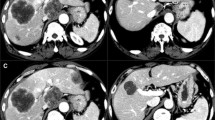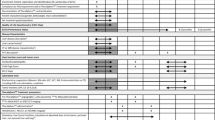Abstract
Background
Reports show that selective internal radiation therapy (SIRT) may downsize inoperable liver tumors to resection or transplantation, or enable a bridge-to-transplant. A small-cohort study found that long-term survival in patients undergoing resection following SIRT appears possible but no robust studies on postsurgical safety outcomes exist. The Post-SIR-Spheres Surgery Study was an international, multicenter, retrospective study to assess safety outcomes of liver resection or transplantation following SIRT with yttrium-90 (Y-90) resin microspheres (SIR-Spheres®; Sirtex).
Methods
Data were captured retrospectively at participating SIRT centers, with Y-90 resin microspheres, surgery (resection or transplantation), and follow-up for all eligible patients. Primary endpoints were perioperative and 90-day postoperative morbidity and mortality. Standard statistical methods were used.
Results
The study included 100 patients [hepatocellular carcinoma: 49; metastatic colorectal cancer (mCRC): 30; cholangiocarcinoma, metastatic neuroendocrine tumor, other: 7 each]; 36% of patients had one or more lines of chemotherapy pre-SIRT. Sixty-three percent of patients had comorbidities, including hypertension (44%), diabetes (26%), and cardiopathy (16%). Post-SIRT, 71 patients were resected and 29 received a liver transplant. Grade 3+ peri/postoperative complications and any grade of liver failure were experienced by 24 and 7% of patients, respectively. Four patients died <90 days postsurgery; all were trisectionectomies (mCRC: 3; cholangiocarcinoma: 1) and typically had one or more previous chemotherapy lines and presurgical comorbidities.
Conclusions
In 100 patients undergoing liver surgery after receiving SIRT, mortality and complication rates appeared acceptable given the risk profile of the recruited patients.
Similar content being viewed by others
References
Ahmadzadehfar H, Biersack HJ, Ezziddin S. Radioembolization of liver tumors with yttrium-90 microspheres. Semin Nucl Med. 2010;40:105–121.
Bester L, Meteling B, Pocock N, et al. Radioembolization versus standard care of hepatic metastases: comparative retrospective cohort study of survival outcomes and adverse events in salvage patients. J Vasc Interv Radiol. 2012;23:96–105.
Mulcahy MF, Lewandowski RJ, Ibrahim SM, et al. Radioembolization of colorectal hepatic metastases using yttrium-90 microspheres. Cancer. 2009;115:1849–1858.
Rhee TK, Lewandowski RJ, Liu DM, et al. 90Y Radioembolization for metastatic neuroendocrine liver tumors: preliminary results from a multi-institutional experience. Ann Surg. 2008;247:1029–1035.
Sangro B, Carpanese L, Cianni R, et al. Survival after yttrium-90 resin microsphere radioembolization of hepatocellular carcinoma across Barcelona clinic liver cancer stages: a European evaluation. Hepatology. 2011;54:868–878.
Seidensticker R, Denecke T, Kraus P, et al. Matched-pair comparison of radioembolization plus best supportive care versus best supportive care alone for chemotherapy refractory liver-dominant colorectal metastases. Cardiovasc Intervent Radiol. 2012;35:1066–1073.
Ahmadzadehfar H, Meyer C, Ezziddin S, et al. Hepatic volume changes induced by radioembolization with 90Y resin microspheres. A single-centre study. Eur J Nucl Med Mol Imaging. 2013;40:80–90.
Chua TC, Bester L, Akther J, Morris DL. Successful right hepatectomy after four treatments of yttrium-90 microspheres (SIR-Spheres) and concomitant FOLFOX as bridging therapy to resection of colorectal liver metastases. Anticancer Res. 2010;30:3005–3007.
9. Fernandez-Ros N, Silva N, Bilbao JI, et al. Partial liver volume radioembolization induces hypertrophy in the spared hemiliver and no major signs of portal hypertension. HPB (Oxford). 2014;16:243–249.
Gaba RC, Lewandowski RJ, Kulik LM, et al. Radiation lobectomy: preliminary findings of hepatic volumetric response to lobar yttrium-90 radioembolization. Ann Surg Oncol. 2009;16:1587–1596.
Gulec SA, Pennington K, Hall M, Fong Y. Preoperative Y-90 microsphere selective internal radiation treatment for tumor downsizing and future liver remnant recruitment: a novel approach to improving the safety of major hepatic resections. World J Surg Oncol. 2009;7:6.
12. Teo JY, Allen JC Jr, Ng DC, et al. A systematic review of contralateral liver lobe hypertrophy after unilobar selective internal radiation therapy with Y90. HPB (Oxford). 2016;18:7–12.
13. Inarrairaegui M, Pardo F, Bilbao JI, et al. Response to radioembolization with yttrium-90 resin microspheres may allow surgical treatment with curative intent and prolonged survival in previously unresectable hepatocellular carcinoma. Eur J Surg Oncol. 2012;38:594–601.
Lewandowski RJ, Kulik LM, Riaz A, et al. A comparative analysis of transarterial downstaging for hepatocellular carcinoma: chemoembolization versus radioembolization. Am J Transplant. 2009;9:1920–1928.
Tohme S, Sukato D, Chen HW, et al. Yttrium-90 radioembolization as a bridge to liver transplantation: a single-institution experience. J Vasc Interv Radiol. 2013;24:1632–1638.
Radunz S, Treckmann J, Baba HA, et al. Long-term outcome after liver transplantation for hepatocellular carcinoma following yttrium-90 radioembolization bridging treatment. Ann Transpl. 2017;22:215–221.
Henry LR, Hostetter RB, Ressler B, et al. Liver resection for metastatic disease after Y90 radioembolization: a case series with long-term follow-up. Ann Surg Oncol. 2015;22:467–474.
Dindo D, Demartines N, Clavien PA. Classification of surgical complications: a new proposal with evaluation in a cohort of 6336 patients and results of a survey. Ann Surg. 2004;240:205–213.
Rahbari NN, Garden OJ, Padbury R, et al. Posthepatectomy liver failure: a definition and grading by the International Study Group of Liver Surgery (ISGLS). Surgery. 2011;149:713–724.
Tzeng CW, Vauthey JN. Postoperative complications and oncologic outcomes after resection of colorectal liver metastases: the importance of staying on track. Ann Surg Oncol. 2013;20:2457–2459.
Langella S, Russolillo N, Forchino F, et al. Impact of obesity on postoperative outcome of hepatic resection for colorectal metastases. Surgery. 2015;158:1521–1529.
Amptoulach S, Gross G, Kalaitzakis E. Differential impact of obesity and diabetes mellitus on survival after liver resection for colorectal cancer metastases. J Surg Res. 2015;199:378–385.
Wang H, Yang J, Zhang X, Yan L. Liver resection in hepatitis B-related hepatocellular carcinoma: clinical outcomes and safety in overweight and obese patients. PLoS ONE. 2014;9:e99281.
Fuks D, Nomi T, Ogiso S, et al. Laparoscopic two-stage hepatectomy for bilobar colorectal liver metastases. Br J Surg. 2015;102:1684–1690.
Lodewick TM, de Jong MC, van Dam RM, et al. Effects of postoperative morbidity on long-term outcome following surgery for colorectal liver metastases. World J Surg. 2015;39:478–486.
Morris-Stiff G, Marangoni G, Hakeem A, et al. Redefining major hepatic resection for colorectal liver metastases: analysis of 1111 liver resections. Int J Surg. 2016;25:172–177.
Narita M, Oussoultzoglou E, Fuchshuber P, et al. What is a safe future liver remnant size in patients undergoing major hepatectomy for colorectal liver metastases and treated by intensive preoperative chemotherapy? Ann Surg Oncol. 2012;19:2526–2538.
Urbani L, Masi G, Puccini M, et al. Minor-but-complex liver resection: an alternative to major resections for colorectal liver metastases involving the hepato-caval confluence. Medicine. 2015;94:e1188.
Vibert E, Pittau G, Gelli M, et al. Actual incidence and long-term consequences of posthepatectomy liver failure after hepatectomy for colorectal liver metastases. Surgery. 2014;155:94–105.
Wolf PS, Park JO, Bao F, et al. Preoperative chemotherapy and the risk of hepatotoxicity and morbidity after liver resection for metastatic colorectal cancer: a single institution experience. J Am Coll Surg. 2013;216:41–49.
Zhou YM, Zhang XF, Li B, et al. Postoperative complications affect early recurrence of hepatocellular carcinoma after curative resection. BMC Cancer. 2015;15:689.
Li GZ, Speicher PJ, Lidsky ME, et al. Hepatic resection for hepatocellular carcinoma: do contemporary morbidity and mortality rates demand a transition to ablation as first-line treatment? J Am Coll Surg. 2014;218:827–834.
Wicherts DA, de Haas RJ, Andreani P, et al. Short- and long-term results of extended left hepatectomy for colorectal metastases. HPB (Oxford). 2011;13:536–543.
Schadde E, Schnitzbauer AA, Tschuor C, et al. Systematic review and meta-analysis of feasibility, safety, and efficacy of a novel procedure: associating liver partition and portal vein ligation for staged hepatectomy. Ann Surg Oncol. 2015;22:3109–3120.
Dai WC, Chan SC, Chok KS, et al. Good long term survival after primary living donor liver transplantation for solitary hepatocellular carcinomas up to 8 cm in diameter. HPB. 2014;16:749–757.
Lei JY, Yan LN, Wang WT. Transplantation vs resection for hepatocellular carcinoma with compensated liver function after downstaging therapy. World J Gastroenterol. 2013;19:4400–4408.
Wan P, Zhang JJ, Li QG, et al. Living-donor or deceased-donor liver transplantation for hepatic carcinoma: a case-matched comparison. World J Gastroenterol. 2014;20:4393–4400.
Allard MA, Cunha AS, Gayet B, et al. Early and long-term oncological outcomes after laparoscopic resection for colorectal liver metastases: a propensity score-based analysis. Ann Surg. 2015;262:794–802.
Vigano L, Capussotti L, Majno P, et al. Liver resection in patients with eight or more colorectal liver metastases. Br J Surg. 2015;102:92–101.
Lee KK, Kim DG, Moon IS, et al. Liver transplantation versus liver resection for the treatment of hepatocellular carcinoma. J Surg Oncol. 2010;101:47–53.
Ito T, Tanaka S, Iwai S, et al. Outcomes of laparoscopic hepatic resection versus percutaneous radiofrequency ablation for hepatocellular carcinoma located at the liver surface: a case-control study with propensity score matching. Hepatol Res. 2016;46(6):565–74.
Yankol Y, Mecit N, Kanmaz T, et al. Lessons learned from review of a single center experience with 500 consecutive liver transplants in a region with insufficient deceased-donor support. Exp Clin Transpl 2016;14(2):191–200.
Narita M, Oussoultzoglou E, Bachellier P, et al. Post-hepatectomy liver failure in patients with colorectal liver metastases. Surg Today. 2015;45:1218–1226.
Wiggans MG, Fisher S, Adwan H, et al. Partial preservation of segment IV confers no benefit when performing extended right hepatectomy for colorectal liver metastases. HPB Surg. 2013;2013:458641.
Shindoh J, Tzeng CW, Aloia TA, et al. Safety and efficacy of portal vein embolization before planned major or extended hepatectomy: an institutional experience of 358 patients. J Gastrointest Surg. 2014;18:45–51.
Wong TC, Cheung TT, Chok KS, et al. Treatment strategy to improve long-term survival for hepatocellular carcinoma smaller than 5 cm: major hepatectomy vs minor hepatectomy. World J Surg. 2014;38:2386–2394.
Garlipp B, de Baere T, Damm R, et al. Left-liver hypertrophy after therapeutic right-liver radioembolization is substantial but less than after portal vein embolization. Hepatology. 2014;59:1864–1873.
Braat AJ, Huijbregts JE, Molenaar IQ, et al. Hepatic radioembolization as a bridge to liver surgery. Front Oncol. 2014;4:199.
Acknowledgments
The authors acknowledge the editorial assistance provided by Martin Gilmour of ESP Bioscience, Crowthorne, UK, funded by Sirtex, during the preparation of this manuscript. The guidelines issued by the International Committee of Medical Journal Editors and Good Publication Practice-3 were adhered to for the development of the manuscript.
Funding
This study was sponsored by Sirtex, with set funding provided for each study entrant, assuming 80% of the required data were collected. The authors received no payment for their involvement as authors of this manuscript.
Disclosure
Independently of P4S, the authors declare the following additional conflicts. Fernando Pardo has received lecture and consulting fees from Sirtex Medical; Bruno Sangro has received lecture and consulting fees from Sirtex Medical; Derek Manas has received support for travel to meetings, as well as honoraria for lecturing and attendance at advisory boards from Sirtex Medical; Pierce K. Chow has received honoraria and research grants from Sirtex Medical; Fernando Rotellar has received travel support and lecture and consulting fees from Sirtex Medical; IB has received lecture fees from Sirtex Medical. Paul J. Gow, Geert Maleux,Gianluca Masi, Lourens Bester, David L. Morris, Wan Y. Lau, Konstantinos Kouladouros, Georgios Katsanos, and Giorgio Ercolani have no conflict of interest to declare.
Author information
Authors and Affiliations
Corresponding author
Electronic supplementary material
Below is the link to the electronic supplementary material.
Rights and permissions
About this article
Cite this article
Pardo, F., Sangro, B., Lee, RC. et al. The Post-SIR-Spheres Surgery Study (P4S): Retrospective Analysis of Safety Following Hepatic Resection or Transplantation in Patients Previously Treated with Selective Internal Radiation Therapy with Yttrium-90 Resin Microspheres. Ann Surg Oncol 24, 2465–2473 (2017). https://doi.org/10.1245/s10434-017-5950-z
Received:
Published:
Issue Date:
DOI: https://doi.org/10.1245/s10434-017-5950-z




